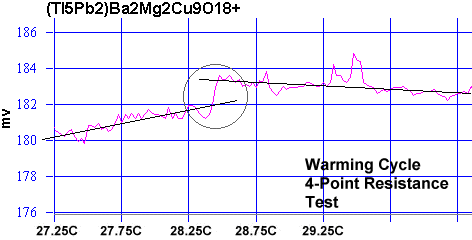
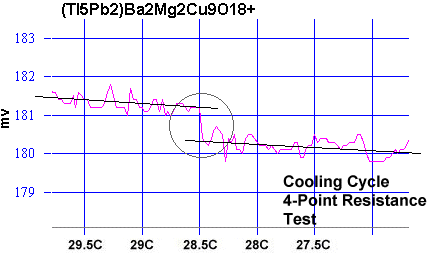

These are "tantalizing hints" of room-temperature superconductivity.
- Dr. Thom Mason, Director, Oak Ridge National Laboratory
"Good job."
- Dr. Yates Coulter, Superconductivity Technology Center,
Los Alamos National Laboratory



The question of whether room-temperature superconductivity (RTSC) is possible in the copper-oxides has been answered. Superconductors.ORG herein reports the observation of superconductivity near 28 Celsius (83F, 301K) in a senary oxycuprate.
Normally, extreme cold is required to cool even a "high temperature" superconductor below its critical transition temperature (Tc). To make this discovery, no cooling was required. For the first time a cryostat actually had to be heated to witness a superconductive phase transition.
The hallmark of superconductivity is a sudden resistance drop to zero ohms and strong diamagnetism (the Meissner effect) near the same temperature. In numerous tests a small amount of the compound (Tl5Pb2)Ba2Mg2Cu9O18+ consistently produced sharp resistive transitions near 28.5 Celsius (see above graphics), and diamagnetic transitions also near 28.5C (see below)1. The transitions were unambiguous, repeatable, and at ambient pressure, making this the first observation of true room-temperature superconductivity in a copper-oxide. Unfortunately, like the 18C superconductor discovered in March 2011, these transitions occurred in a noisy environment, suggesting the volume fraction is very low. As such, any plans for immediate commercialization will have to wait for a refinement method to be developed.
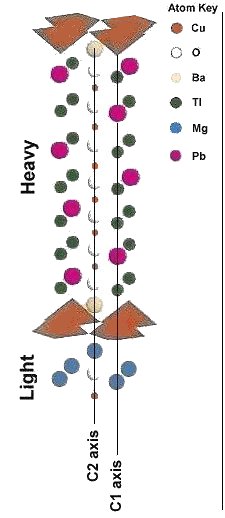
|
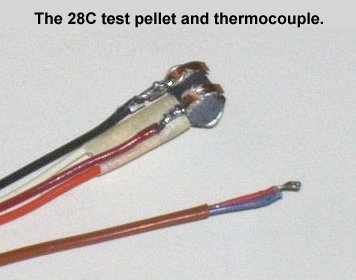 This achievement came as a result of efforts to reformulate the 18C superconductor discovered in March 2011. The key to improving that material was substitution of a magnesium atom into one of the C2 copper sites (see "LIGHT" region of D223 graphic at left). By doing this the planar weight ratio (PWR) of the C2 axis increases, while the PWR of the C1 axis remains unchanged. Research since 2005 has confirmed a direct correlation between PWR and Tc. Logically, the next evolutionary step might be to place magnesium atoms into both C2 copper sites. But, experience has shown every metallic non-copper layer must have a copper layer adjacent to it on at least one side. 2 Mg atoms in the LIGHT C2 would necessitate a copper in the LIGHT C1 to meet this requirement. However, since Cu is over 2.5 times as heavy as Mg, that would significantly lower the C1 PWR, causing a drop in Tc. |
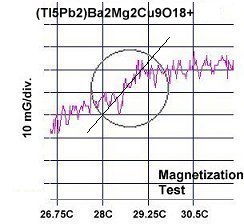
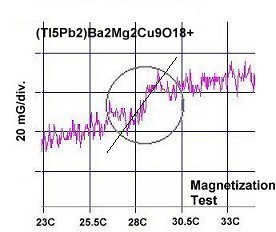
The plots of two sequential magnetization tests are shown above. The Meissner transition in the plots represents about 10 milli-Gauss with a -10db noise floor. The signal-to-noise ratio can be improved 3db by digitally summing these plots together, producing the below composite. The straight lines represent the average of the noise component, skewing apart at 28.5C.
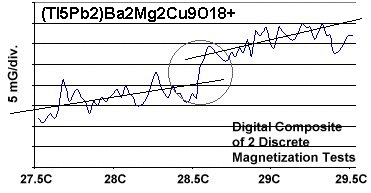
The parent structures that previously established world records in this family of perovskites are shown below for comparison. The resistive Tc produced by each structure is noted below it as a Celsius or Kelvin temperature.
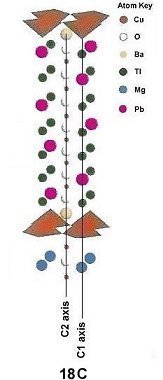
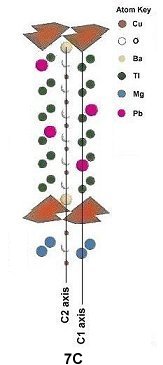
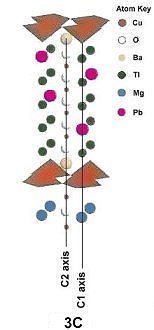
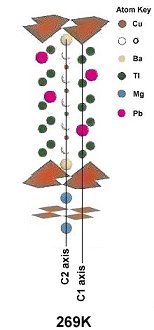
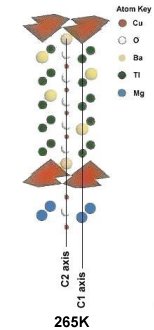
Dots have been placed within the C1 plot below, depicting where D223(Tl5Pb2-Mg2) lies relative to the other high performance thallium-cuprates. Temperatures plotted (in Kelvin) are resistive. The C2 plot of PWR-v-Tc is not shown.
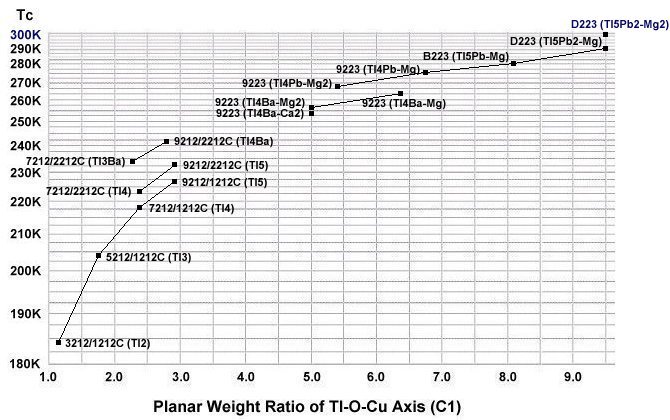
As with prior discoveries that advanced high Tc through asymmetry along the C axis, (Tl5Pb2)Ba2Mg2Cu9O18+ does not form stoichiometrically (by conventional mixing of chemicals). It must be synthesized using the layer cake method, as shown below. The prototype pellets each had roughly 50 to 60 interference layers. And, even using this technique, the volume fraction is low, requiring very sensitive test equipment.
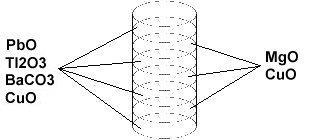
The below stoichiometric ratios were used for the ODD layers:
PbO 99.99% (Alfa Aesar) 2.88 grains...and the below ratios for the EVEN layers.
MgO 99.95% (Alfa Aesar) 2.08 grains (4x stoichiometric)The chemical precursors were pelletized at 70,000 PSI and sintered for 35-36 hours at 865C. The pellet was then annealed for 10 hours at 500C in flowing O2. The 4-point probe was bonded to the pellet with CW2400 silver epoxy and used 7 volts on the primary, with a 50-ohm series resistor. Temperature was determined using an Omega type "T" thermocouple and precision OP77 DC amplifier. The magnetometer employed twin Honeywell SS94A1F Hall-effect sensors with a tandem sensitivity of 50 mv/Gauss.
RESEARCH NOTE: The copper-oxides are strongly hygroscopic. All tests should be performed immediately after annealing.
RE-PUBLICATION NOTICE: Elsevier Publishing, dba Elsevier Science, as well as Morris Communications, both print and broadcast divisions, are specifically prohibited from re-publishing any part of this news story.
E. Joe Eck
Provisional Patent US61/630,114
© 2011, 2012 Superconductors.ORG
All rights reserved.
1. Testing temperatures are believed accurate within +/- 1 degree C.
 BACK to "News" page at Superconductors.ORG
BACK to "News" page at Superconductors.ORG